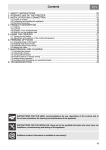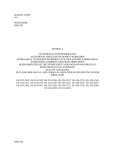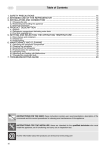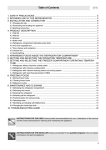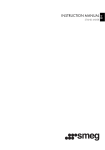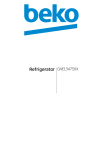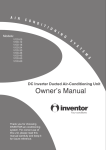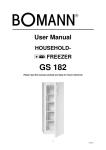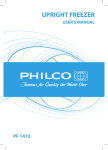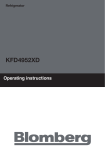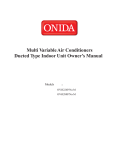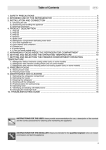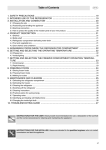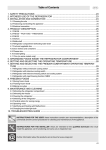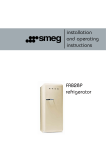Download User instructions
Transcript
Contents 1. SAFETY PRECAUTIONS ...................................................................................................... 26 2. ENVIRONMENTAL CARE ..................................................................................................... 28 3. INTENDED USE OF THE REFRIGERATOR ......................................................................... 29 4. PRODUCT DESCRIPTION .................................................................................................... 30 4.1 Shelves ......................................................................................................................................................... 31 4.2 Fruit and vegetable drawer ........................................................................................................................... 31 4.3 Door ledges and containers .......................................................................................................................... 31 4.4 Cheese box ................................................................................................................................................... 31 4.5 Quick freezing compartment ......................................................................................................................... 31 4.6 Super-cold shelves ....................................................................................................................................... 32 4.7 Interior lighting .............................................................................................................................................. 32 5. FUNCTIONS AND FEATURES ............................................................................................. 33 5.1 Thermostat settings ...................................................................................................................................... 33 6. USING THE APPLIANCE ...................................................................................................... 34 6.1 Switching the appliance on ........................................................................................................................... 34 6.2 Arranging foods inside the refrigerator compartment .................................................................................... 34 6.3 Freezing of foods .......................................................................................................................................... 36 6.5 Defrosting deep-frozen foods ........................................................................................................................ 37 6.4 Keeping deep-frozen foods ........................................................................................................................... 37 6.6 Making ice cubes .......................................................................................................................................... 38 7. MAINTENANCE AND CLEANING ........................................................................................ 39 7.1 Cleaning the refrigerator ............................................................................................................................... 39 7.2 Switching off the refrigerator ......................................................................................................................... 40 7.3 Practical energy saving advice ..................................................................................................................... 40 7.4 Noises during operation ................................................................................................................................ 40 7.5 Identifying and eliminating any operational faults ......................................................................................... 40 7.6 Replacing the inside light bulbs .................................................................................................................... 41 8. TROUBLESHOOTING ........................................................................................................... 42 9. INSTALLATION AND CONNECTION .................................................................................... 45 9.1 Choice of location ......................................................................................................................................... 45 9.2 Positioning the appliance and making sure it's level ..................................................................................... 46 9.3 Electrical connection ..................................................................................................................................... 46 I NSTRUCTIONS FOR THE USER: recommendations for use, description of commands and the correct procedures for cleaning and maintenance of the appliance. INSTRUCTIONS FOR THE INSTALLER: these are for the qualified technician who must carry out the installation, commissioning and testing of the appliance. @ Additional product information is available at www.smeg.it 25 General warnings 1. SAFETY PRECAUTIONS Keep the instruction handbook in a safe place; it contains important information which must be followed when installing, using and servicing the refrigerator. The manual must be kept so that it can be handed over to any future owners of the appliance. The manufacturer cannot be held liable if the following notices are not respected: Read this manual before installing and switching on the household appliance. The manufacturer declines all responsibility in case of incorrect installation and use or failure to comply with the precautions described in this manual. Do not start up an appliance which appears damaged: if in doubt, consult the supplier. The appliance must be installed and connected to the electrical mains in full compliance with the instructions provided in the handbook. The electrical connection conditions must be as specified on the nameplate , which is in the bottom left-hand corner of the body of the refrigerator. The appliance's electrical safety is only guaranteed if the household electrical system is earthed in accordance with the relevant regulations. Make sure that all repairs and servicing are only carried out by authorised engineers from the Smeg after-sales service. Always disconnect the appliance from the electrical mains in case of breakdown and maintenance, when changing light-bulbs or during cleaning. Never defrost using electrical devices or steam cleaners. Never remove frost or ice with sharp items, as this may cause irreparable damage to the walls of the refrigerator. This appliance may be used by children from the age of 8 and by people of reduced physical and mental ability or lacking in experience and knowledge, provided they are supervised or instructed on the safe use of the appliance and if they understand the associated risks. Do not allow children to play with the appliance. Do not allow unsupervised children to perform cleaning or maintenance operations. Attention: do not use mechanical devices or any other artificial means to speed up the thawing process. This appliance is not intended for use by persons (including children) with reduced physical, sensory or mental capabilities, or lack of experience and knowledge, unless they have been given supervised or instruction concerning use of the appliance by a responsible person for their safely Young children should be supervised to ensure that they do not play with the appliance. Do not attempt to operate a damaged appliance: in case of doubt, contact your dealer. Do not use adapters or shunts that could cause overheating or burns. Do not use old or twisted power cords. Do not twist or bend power cords. Do not introduce the plug into the power socket with wet hands. Do not use electrical equipment (such as ice cream makers or blenders) inside the appliance If the supply cord is damaged, it must be replaced by manufacturer or its service agent or a similarly qualified person in order to avoid a hazard. Never attempt to move the refrigerator by pulling on the door or the handle. 26 General warnings Keep alcoholic liquids with a high alcohol content hermetically sealed and always in a vertical position. Do not keep liquids in tins or glass containers in the freezer compartment, especially carbonated drinks. Do not keep products containing gases, flammable propellants or explosive substances in the freezer: danger of explosion! electrical appliances (e.g. ice cream machines or blenders) may not be used inside the appliance. To ensure the refrigerator operates correctly, never obstruct or cover the air ducts in any way. Do not touch (especially with wet hands) or put into your mouth frozen products removed straight from the freezer or cooling surfaces. There is a risk of burns due to the ultra-low temperatures. Never eat or drink foods which look or smell strange. Never allow children to play with the refrigerator, and use the drawers, shelves or other parts of the appliance only as described in this handbook; never use them for purposes other than those for which they are designed. If there is a power cut, open the door(s) as little as possible. Frozen food which has been partially or completely defrosted must not be refrozen. Attention: this refrigerator contains a small quantity of isobutane (R600a), a CFC-free gas refrigerant. During the transport, installation, cleaning and repair of the fridge, make sure that you avoid damage to any part of the cooling circuit in order to prevent a gas leak. In the event of damage, avoid the use of naked flames and ventilate the area where the appliance is located. 27 Disposal instructions 2. ENVIRONMENTAL CARE Our refrigerators are packaged using only non-polluting, environmentally-friendly, recyclable materials. Please help by disposing of the packing correctly. Ask your supplier or the relevant organisations in your area for the addresses of collection, recycling and disposal centres. Your old appliance also needs to be disposed of correctly. Important: hand over your appliance to the local agency authorised for the collection of electrical appliances no longer in use. Proper disposal will enable valuable materials to be recovered. Refrigeration appliances contain gases that can be harmful to the environment, so you need to ensure that the tubes in the coolant loop are not damaged before the relevant organisation takes the appliance away. Before scrapping your refrigerator it is important to remove doors and leave the shelves in position, to ensure that children cannot accidentally become trapped inside during play. The power grid connection cable must also be removed and disposed of separately together with the plug. THIS APPLIANCE IS IDENTIFIED IN ACCORDANCE WITH EUROPEAN DIRECTIVE 2002/96/EC ON WASTE ELECTRICAL AND ELECTRONIC EQUIPMENT (WEEE). THIS GUIDELINE IS THE FRAME OF A EUROPEAN-WIDE VALIDITY OF RETURN AND RECYCLING ON WASTE ELECTRICAL AND ELECTRONIC EQUIPMENT. 28 User instructions 3. INTENDED USE OF THE REFRIGERATOR The appliance is specifically constructed for domestic use and is therefore suitable for the refrigeration and storage of fresh and frozen foods and the production of ice-cubes. The appliance is not designed and manufactured for professional use. Smeg cannot be held liable for any damage incurred as a result of incorrect use of the appliance. The refrigerator has undergone the necessary tests on refrigerant circuit tightness.and complies with the safety regulations for electrical appliances. Attention: The manufacturer cannot be held liable for any personal injury or property damage caused by failure to observe the above requirements or by tampering with any part of the appliance or using non-original spare parts. 29 User instructions 4. PRODUCT DESCRIPTION 30 1 Quick freezing compartment 2 Ice cube tray 3 Ice container 4 Freezer thermostat 5 Freezer shelf 6 Freezer compartment (ffff) 7 Freezer light 8 Super-cold shelves 9 Refrigerator thermostat 10 Refrigerator light 11 Refrigerator shelves 12 Cheese box 13 Drawer cover 14 Vegetable crisper 15 Anti-tip bottle racks 16 Freezer shelf (ff) 17 Egg container 18 Top shelf with flap 19 Egg shelf 20 Herb compartment 21 Bottle shelf User instructions 4.1 Shelves Each refrigerator comes complete with several shelves which can be set at different heights by placing them on the runners provided. In order to remove all the internal accessories, the door needs to be fully open. 4.2 Fruit and vegetable drawer These containers are at the bottom of the refrigerator compartment, which is fitted with a glass shelf to cover fresh foods that require constant humidity for optimum storage. When the fruit and vegetable drawer is completely full, the fresh food dial (A) on the front part of the drawer should be open. This way the air and humidity level can be controlled and foods will maintain their freshness longer. 4.3 Door ledges and containers The inside of the door is fitted with special shelves and boxes to hold eggs, butter, dairy products, tubes, preserves and other similar small items. The bottom of the door has a shelf to hold vertical bottles. To stop bottles from falling when the door is opened and closed, they must be secured with the special retainer rod supplied. All the door ledges and trays can be removed for cleaning. To remove them from the door, tap them upwards with your fist, first on one side and then on the other in the insertion zone. 4.4 Cheese box A special cheese box with lid is supplied This box can be placed on any shelf as required. 4.5 Quick freezing compartment Use the quick freezing compartment to freeze food cooked at home (and fresh food that needs to be frozen) faster, due to the increased cooling capacity of the freezing chamber. To open the compartment raise the cover and place the item in the compartment. It closes in the same way. Note: ensure that the quick freezing compartment cover is closed before closing the door. Otherwise, it loses its quick freezing capacity. 31 User instructions 4.6 Super-cold shelves Storing food in the super-cold compartment instead of the freezer or refrigerator compartments allows the food to maintain its freshness and flavour longer, preserving its appearance. When the super-cold tray becomes dirty, remove and rinse it under water. Water freezes at 0°C, but food that contains salt or sugar freeze at lower temperatures. Normally the super-cold compartment is used for fresh fish, food in light brine, rice, etc. ... Do not place food that you want to freeze here or trays to make ice. 4.7 Interior lighting When the refrigerator and/or freezer door is open, the light comes on and stays lit until the door is completely closed. A safety device automatically switches off the light if the door is left open for too long. The same device switches the light on again when it is no longer at risk of overheating. 32 User instructions 5. FUNCTIONS AND FEATURES 5.1 Thermostat settings 1 Freezer thermostat 2 Refrigerator thermostat The thermostat of the freezer and the refrigerator will automatically adjust the temperature inside the compartments. Lower temperatures can be obtained by turning the knob from position 1 to 5. In cold seasons it is advisable to set higher temperatures to reduce energy consumption. Freezer thermostat setting; 1 - 2: Place the knob between the minimum and the average position for the short-term storage of food in the freezer. 3 - 4: Turn the knob to the average position for the long-term storage of food in the freezer. 5: For freezing fresh food. The appliance works longer. After reaching the coolest temperature, you must return it to its original position. Refrigerator thermostat setting; 1 - 2: For a low cold setting. 3 - 4: For a normal cold setting. 5: For a high cold setting. 33 User instructions 6. USING THE APPLIANCE 6.1 Switching the appliance on After connecting the device to the power supply, see section "9.3 Electrical connection", adjust the thermostats as described above. When first turned on, the appliance must operate continuously for 24 hours before cooling to a suitable temperature. During this period do not open the door too often and do not place large amounts of food inside the appliance. When the appliance is switched off or unplugged, wait at least 5 minutes before restarting or plugging it in so as not to damage the compressor. Important Changes in climatic conditions (temperature and humidity) and the frequency with which fresh food is put into the compartments and the door is opened affect the appliance’s operating temperatures. 6.2 Arranging foods inside the refrigerator compartment Arrange the foods on the various shelves, taking care that they have an airtight wrapping or cover. This precaution ensures that: - the flavour, moisture and freshness of the foods can be preserved; - any contamination of foods with odours or tastes from other foods can be avoided. - the humidity level inside the refrigerator is prevented from becoming too high as a result of the normal transpiration of food (especially fresh fruit and vegetables). In some operating conditions (rise in ambient temperature and humidity, more frequent opening of the door) this might cause condensation to form on the shelves. Suitably prepare the meat and cleaned fish that will be consumed within 1-2 days(by enclosing them.in containers or wrapping them in plastic). Fruits and vegetables can be inserted into the appropriate compartment without being packed. - 34 Only use containers suitable for keeping food in. Always allow hot foods and drinks to cool to room temperature before putting them in the compartment. To reduce moisture and the consequent increase of frost never put liquids in open containers inside the refrigerator. Do not keep explosive substances in the appliance and only keep drinks with a high alcohol content in it if they are properly closed and kept vertical. User instructions The NO-FROST system with which the appliance is equipped ensures a constant temperature and higher cooling power. The air which is fan-driven is free of humidity and quickly dries the food placed in the refrigerator compartment. This is another reason to make sure that the food placed in the refrigerator is sealed. The dry ventilation air chills the food more quickly; the NO FROST system ensures that the temperature is kept more constant Place the food inside the refrigerator compartment as shown in the diagram 6.2.1 Special meat and fish storage compartment Some delicate foods such as meat, fish and lightly frozen foods can be stored in the special super-cold drawer, in which the temperature is constantly kept at around 0°C. 35 User instructions 6.3 Freezing of foods The freezer is used for the long-term storage of deep frozen or frozen foods for a long period of time and for the making of ice cubes. Use the shelf for quick freezing to freeze food prepared at home (and any other food requiring freezing) more quickly thanks to the increased freezing strength of the freezer compartment. To keep and freeze foods properly, you are advised to pack fruit and vegetables in portions of no more than 1 kg and meat and fish in portions of up to 2 kg. Smaller food packages freeze more quickly which means that the foods' nutritional and taste properties are preserved better, including after defrosting and preparation. Only use suitable freezer bags, tinfoil, cling-film for use with food, and freezer containers. Do not use paper bags, cellophane bags for non-food use and shopping bags or pre-used freezer bags. Package foods in hermetically sealed packages, attempting to ensure that all air is expelled. If using bags, close them with suitable elastic bands or wire ties. Always allow hot foods to cool down to room temperature before putting them in the freezer and ensure that foods which are already frozen do not come into contact with fresh foods for freezing. Always write the date of freezing, the quantity and product on the package, and make sure that foods are fresh and whole. The max. amount of fresh foods which can be frozen in a 24-hour period is marked on the rating plate. Do not exceed the quantity specified: this can have a negative effect on the efficiency of the freezer and the capacity to preserve the deep-frozen foods which are already in it. For optimal performance of the appliance so that it reaches the maximum freezing capacity, turn the thermostat knob to the highest position 24 hours before putting fresh food into the freezer. After putting fresh food into the freezer, 24 hours at the maximum position is usually sufficient. After 24 hours, it is not necessary to leave the thermostat of the freezer turned to the maximum position. Caution; to save energy, when you freeze small amounts of food, it is not necessary to set the thermostat of the freezer to the maximum position. If the wrapper of the frozen food shows signs of moisture or abnormal swelling, it may not have previously been stored at a proper temperature and the contents may be damaged. In case of power failure, the freezer compartment maintains its temperature for around 18 hours. 36 User instructions 6.4 Keeping deep-frozen foods When buying deep-frozen foods, always make sure that the packaging is not damaged, the product has not past its expiry date and the thermometer of the freezer in which the food is displayed for sale does not indicate a temperature above –18°C. Also note the manufacturer's instructions regarding temperature, period for which the food can be kept and consumption methods. You are also advised to protect the foods you have bought with suitable insulated containers during transport to avoid defrosting. A temperature increase may reduce the period for which the food can be kept and affect the quality of it. Do not buy deep-frozen products covered in large amounts of frost: they may have already defrosted. FOOD 1 Vegetables Fruit Bread and confectionery Milk Ready meals Meat: beef veal pork poultry game minced meat Smoked sausage Fish: oily non-oily Chitterlings 2 3 STORAGE PERIOD (IN MONTHS) 4 5 6 7 8 9 + + 10 + + 11 12 + + + + + + + + + + + + + + + + + + + + + + + + + To avoid any alterations in the quality of frozen foods, do not exceed the permitted storage period, which varies depending on the type of food. 6.5 Defrosting deep-frozen foods You are advised to consume partially defrosted foods as soon as possible. Low temperatures preserve the foods but do not destroy the microorganisms which become active after defrosting, potentially leading to a deterioration in the products. If the smell and appearance of defrosted foods appears to be unchanged, they can be cooked and potentially refrozen after they have cooled. To defrost frozen foods correctly, depending on the type of food and the intended use, they can be defrosted at room temperature, in the fridge, in an electric oven (static or fan-assisted oven function) or in a microwave oven using the appropriate setting. 37 User instructions 6.6 Making ice cubes Fill the tray provided (3) up to the indicated level with cold water or any other liquid that you wish to freeze. Place it inside the freezer compartment in its original position. To remove the ice cubes and drop them into the prepared container (1), rotate the lever (2). Do not fill the ice container with water (1) in order to produce the ice. It may break. 38 User instructions 7. MAINTENANCE AND CLEANING 7.1 Cleaning the refrigerator Before cleaning, disconnect the plug from the electrical mains. To clean the outside of the freezer, use water and a gentle liquid detergent only, or a detergent for general use on washable surfaces (e.g. a detergent for use on glass). Never use products containing abrasives or substances which may attack the lacquered or painted parts, acids or chemical solvents. Use a sponge or a soft cloth. To clean the inside do not use steam cleaners; we recommend the use of specific sanitizing products such as a solution of sodium bicarbonate/soda and warm water. Specific SMEG-brand products for cleaning steel are available from our Service Centres. Remove the shelves and accessories, taking care not to apply excessive force when removing. Do not wash removeable plastic parts in the dishwasher, just use lukewarm water and washing up liquid or a water and vinegar solution. Dry all the parts thoroughly after washing and rinsing them. Do not allow the electrical lighting parts to come into contact with water or detergents. To clean the seals, use lukewarm water and dry them afterwards. To ensure that the refrigerator functions properly, you will also need to clean the condenser at the back periodically, using a brush or a vacuum cleaner (1). Upon completion of cleaning, reconnect the power plug with dry hands. 39 User instructions 7.2 Switching off the refrigerator If the refrigerator is to remain out of use for a long time disconnect it from the mains. Then empty the compartments and dry any residual moisture which has collected. Leave the door ajar to ensure that moisture and stagnant air do not cause unpleasant odours. 7.3 Practical energy saving advice - Install the refrigerator in a cool, well ventilated place, protected from direct sunlight and well away from heat sources; Do not put hot food in the fridge or freezer. Wait for foods and drinks to cool to room temperature before placing them on the shelves; Reduce the number of times that the door(s) is/are opened and the length of time they remain open to prevent the units from heating up excessively; Clean the condenser (rear of the refrigerator) periodically to prevent the appliance from losing efficiency; On models equipped with the rapid freezing function, do not leave this function activated for longer than absolutely necessary; If the refrigerator remains unused for a long period, it is advisable to empty the appliance and disconnect it from the mains; Thaw frozen foods in the body of the refrigerator in order to take advantage of the cold stored in the frozen foods, which will be transferred to the refrigerator if this procedure is used. 7.4 Noises during operation The fridge freezer cools by means of a compression system. In order to maintain the preset temperature inside the refrigerator and freezer sections, the compressor comes into operation in response to the level of cooling required, and may operate continuously if necessary. When the compressor starts to function, it creates a buzzing noise which generally diminishes in intensity after a few minutes. Another normal refrigerator operating noise is a gurgling due to the coolant flowing through the pipes in the circuit. This noise is normal and does not indicate an appliance malfunction. If it becomes too loud, this may mean that there are other causes. Checks must then be made to ensure that: - the refrigerator is properly levelled on the floor and does not vibrate when the compressor is in operation: if this is not the case, adjust the feet it's equipped with; - The drawers, shelves and trays on the door are correctly positioned in their holders: if they are not, put them in correctly; - Bottles and containers on the various shelves are stable and not touching each other: otherwise, the vibration resulting from the compressor's operation could cause a certain amount of noise; - Do not place the fridge in such a way that it is in contact with furniture or other household appliances. 7.5 Identifying and eliminating any operational faults Your new refrigerator is designed and built to strict quality standards. The aim of this section is to enable you to identify the origin of any operational fault that may arise, before contacting Smeg's technical support service. 40 User instructions 7.6 Replacing the inside light bulbs BEFORE PERFORMING ANY OPERATIONS, SWITCH OFF THE POWER SUPPLY TO THE APPLIANCE. Freezer lamps Refrigerator lamps Before replacing the bulb, make sure that its failure to operate is not simply because it has become loose inside the lamp holder. In any case, whether you wish to check that the bulb is inserted correctly or you wish to change it, for safety reasons, you must first remove the plug from the power outlet. Use a screwdriver to unscrew the cover and remove it (in the direction shown by the arrow). Replace the lamp with an equivalent one (max. power 25 W). NOTE In the refrigerator compartment there are 2 bulbs, max. 15 W. Replace the protective cover of the light and, after waiting 5 minutes, reconnect the plug. 41 User instructions 8. TROUBLESHOOTING PROBLEM Noisy during operation POSSIBLE CAUSE - The compressor starts to function too often or functions continuously: The compressor does not function: - Refrigerator sufficiently section not cooled - - - insufficient cooling of the compressor and the condenser: increase in surrounding temperature; doors opened often or for long periods; freezer loaded with too many fresh foods supply cable not connected to the electricity supply; socket not providing any electricity. inside temperature setting thermostat set too low (1-2) (provides a higher temperature inside the appliance); frequent or prolonged door opening; - freeze less food in one go; - connect the supply cable; - contact your electricity supply company Turn the regulator to an intermediate setting. - the door does not close properly increase in surrounding temperature. Door hard to open just after closing: 42 PROBABLE SOLUTION see 'noises during operation' section check that the back of the freezer is properly ventilated as indicated in section “9.1” and that the condenser is not excessively dirty; - open the door less frequently and for as little time as possible; check that the foods are arranged on the shelves correctly and are not preventing the door from closing properly, and that the floor under the refrigerator is level; check that the seal is closing properly and is not damaged. if you attempt to open the door again just after closing it (especially the freezer door), considerable strength is required. This is due to the low pressure created by the cooling of the warm air which has entered the freezer. User instructions PROBLEM Temperature inside freezer section not low enough to freeze foods properly: - - POSSIBLE CAUSE inside temperature setting thermostat set too low; frequent or prolonged door opening; the door does hermetically; not close - Too much condensation forming in refrigerator compartment too much sugar in foods for freezing check that the door gaskets are providing an airtight seal to the refrigerator; frequent opening; - too much fresh food (fruit and vegetables) placed on the shelves. Foods not properly covered or stored in airtight containers cooling temperature regulator device set too high (meaning lower temperature inside the appliance) Temperature inside refrigerator section too cold - fresh foods are freezing: or prolonged door - - - PROBABLE SOLUTION Turn the regulator to intermediate setting. an open the door less frequently and for as little time as possible; check that the foods are arranged on the shelves correctly, that the gasket is sealing properly and is not damaged, and that the floor under the refrigerator is level; some foods may not freeze completely unless they are at very low temperatures (ice cream, juice concentrates) In case of cracks, try to soften the gasket by pulling it with one hand and sliding your fingers (held together - no gaps between them) along the inside; open the door less often and for shorter times, especially when the appliance is working in warm, humid conditions; place less food inside the refrigerator section; Cover the containers and seal foods. Turn the regulator to a lower setting. cover foods using suitable bags and containers; do not place fruit and vegetables inside when too wet do not place foods inside so that they are touching the back of the refrigerator. 43 User instructions PROBLEM Too much ice forming in freezer POSSIBLE CAUSE inside temperature setting thermostat set on too low a temperature; PROBABLE SOLUTION Use the regulator to set a lower cooling temperature to increase the temperature inside the appliance slightly; - check that the gaskets are providing an airtight seal: If they are cracked, try to soften the gasket by pulling it with one hand and sliding your fingers (held together - no gaps between them) along the inside; - open the door less frequently and for less time; - increase the atmospheric temperature and humidity; - do not put hot food or drinks in the freezer; The front of the appliance is warm to - the refrigerator is operating the touch normally. There is a surface heating system inside the cabinet to limit the formation of condensation around the door seal. Doors out of alignment: - check that the floor under the refrigerator is level,and also adjust the two rear feet if necessary. Check whether changing the settings of the two feet improves the alignment. CUSTOMER SUPPORT SERVICE – READING THE IDENTIFICATION PLATE. IF YOU HAVE PROBLEMS WITH THE PRODUCT THAT YOU HAVE PURCHASED WHICH ARE NOT COVERED BY THE TABLE ABOVE AND YOU NEED FURTHER CLARIFICATION, YOU CAN CONTACT OUR AUTHORISED TECHNICAL SUPPORT SERVICE. YOU WILL FIND THE ADDRESS AND TELEPHONE NUMBER IN THE PHONE BOOK FOR YOUR AREA UNDER SMEG. TO SPEED UP THE SERVICE, PLEASE BE READY TO INFORM OUR CALL SERVICE OPERATORS OF THE MODEL OF THE PRODUCT YOU HAVE PURCHASED AND THE SERIAL NUMBER MARKED ON THE NAMEPLATE INSIDE THE BODY OF THE REFRIGERATOR. THANK YOU IN ADVANCE FOR YOUR COOPERATION. 44 Installation instructions 9. INSTALLATION AND CONNECTION 9.1 Choice of location Always place the refrigerator in a dry place with adequate ventilation. Ensure that it is not directly exposed to the sun's rays and do not place it outdoors. Depending on its climate class (stated on the nameplate inside the refrigerator compartment), the appliance can be used in different temperature conditions: Class Room temperature N (Normal) from + 16°C to + 32°C SN (Subnormal) from + 10°C to + 32°C ST (Subtropical) from + 18°C to + 38°C T (Tropical) from + 18°C to + 43°C Never place the refrigerator close to heat sources. If this is unavoidable, in order to prevent the proper operation of the product from being compromised, a suitable insulation board must be used. Otherwise, locate the appliance at least 3 cm away from electrical or gas cookers and at least 30 cm away from combustion heaters or radiators. To allow proper cooling of the condenser, the refrigerator must not be placed too close to the wall. To prevent this, the appliance comes complete with two plastic spacers which must be fitted to the top of the appliance as shown in the drawing. If the refrigerator is installed underneath a wall cupboard, the distance between the two must be at least 5 cm. Do not place heavy objects on the refrigerator. If the appliance is installed next to another refrigerator or a freezer, keep a minimum distance of 2 cm between the devices to prevent condensation. Take care when installing the appliance on parquet or linoleum to avoid scratching or otherwise damaging the floor. If necessary, when positioning slide the refrigerator over pieces of wood or a mat to the point decided on for connection to the electrical mains. To allow the circulation of air below the appliance, the space underneath must kept empty. Do not close it off with a carpet or anything else. 45 Installation instructions 9.2 Positioning the appliance and making sure it's level Place the fridge on a stable and level floor. To compensate for uneven flooring and to allow greater stability of the product, the refrigerator has two adjustable front legs (1). To ensure easier movement and correct positioning of the appliance, four wheels are fitted (2). In any case, we recommend moving the fridge very carefully in order to avoid damaging the floor (especially in the case of wooden floors). The exterior of the appliance and internal accessories should be cleaned with a solution of water and liquid soap; the inside of the appliance with baking soda dissolved in warm water. Replace all the accessories after they have dried. 9.3 Electrical connection Before switching the refrigerator on for the first time, leave it in a vertical position for at least two hours. Connect the supply cable of the appliance to an earthed electrical socket, installed in accordance with electrical safety standards. The rated voltage and frequency are stated on the nameplate inside the refrigerator compartment. The appliance must be connected to the power grid and earthed in accordance with the applicable standards and requirements. Check that the voltage rating on the nameplate is the same as the mains supply. If the supply cable needs to be changed, this procedure must only be carried out by an authorised technician from Smeg's technical support service. The plug must be accessible when the appliance is installed. It is possible that you may detect a smell when the appliance is first switched on. This smell will fade when the appliance begins to cool. 46






















